Coffee, a beloved beverage for most of us, has a rich history and a vast global market. This article is all about the intriguing statistics surrounding coffee consumption and production.
General Coffee Statistics
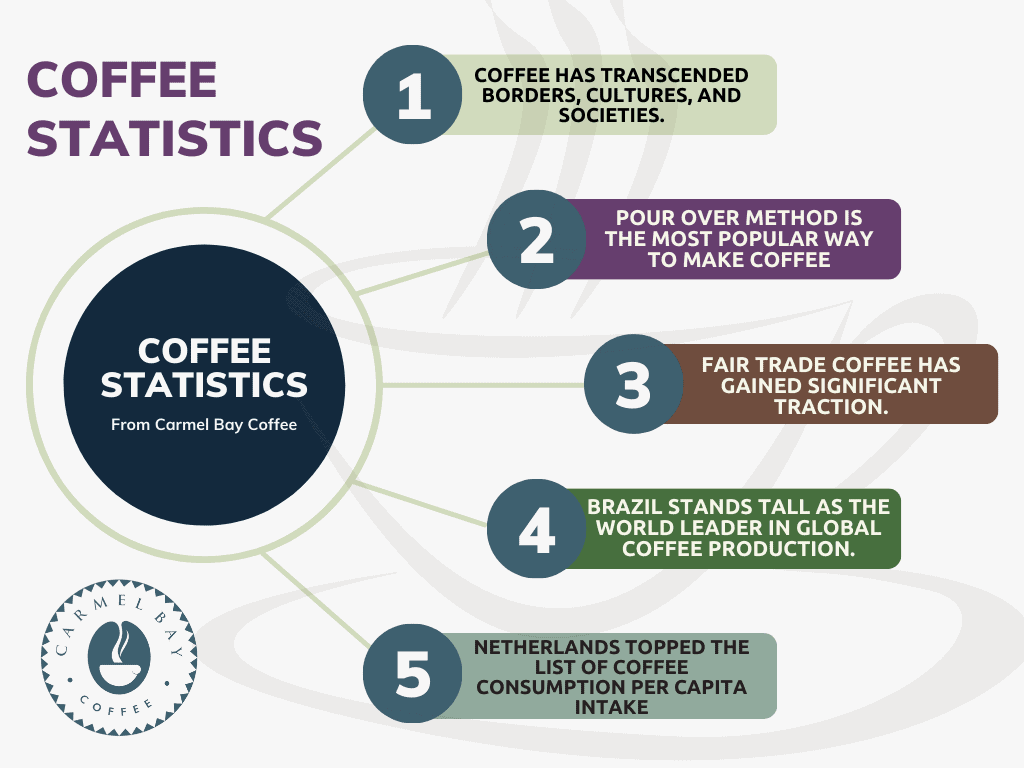
Coffee, often dubbed the world’s favorite beverage, has become an integral part of global cultures, symbolizing unity and warmth. The sheer volume of its consumption is telling, with the Netherlands topping the list in 2015, recording an average of 260.4 liters per person per year.
This affinity for coffee is also seen in the U.S., where a significant 16% of the population consumes four to five cups daily, largely for the love of its flavor.
Brewing methods differ worldwide, but in the U.S., flavored creamers, ranging from traditional hazelnut to seasonal peppermint, are particularly popular. As consumers grow more discerning, fair trade coffee is gaining traction, symbolizing a commitment to ethical trade practices, even if it comes at a higher price.
On the supply side, Brazil stands out as a coffee powerhouse with a history spanning over 150 years. However, its leadership is tested by occasional summer frosts, which can impact harvests and, subsequently, global coffee prices.
A Global Affection for Coffee
Coffee, often called the ‘nectar of the gods,’ is a beverage that transcends borders, cultures, and societies. Its rich aroma and invigorating taste have made it a daily staple for millions worldwide. But how does the world consume this beloved drink?
World’s Leading Coffee Consumers
In 2015, the Netherlands topped the list of coffee consumption with an average per capita intake of 260.4 liters per year. This is a testament to the deep-rooted coffee culture in the country. Surprisingly, among consumers in the U.S., 16 percent reported drinking between four and five cups of coffee per day on average. The reasons cited for this high consumption rate were primarily taste and pleasure.
Brewing Techniques and Preferences
Coffee can be brewed using various techniques, each originating from around the globe. Most methods involve mixing ground coffee with hot water, followed by removing the coffee grounds before consumption. In the U.S., many coffee enthusiasts have preferred variations on standard coffee creamers, such as hazelnut, French vanilla, and seasonal flavors like peppermint and pumpkin.
Fair Trade Coffee
The concept of fair trade coffee has gained significant traction, especially in the U.S. A product bearing the fair trade logo ensures that it is produced and marketed following standards set by a fair trade labeling organization. The primary objective is to ensure ethical business practices, preventing exploitation. Even though fair trade coffee often comes with a higher price tag, its ethical implications make it a preferred choice for many.
Brazil: The Coffee Giant
Brazil stands tall as the world leader in global coffee production. The country’s dominance in the industry spans over 150 years, primarily due to its ideal climate and vast tracts of land dedicated to coffee cultivation. However, the nation has faced challenges, with occasional summer frosts severely impacting the yearly coffee harvests, leading to a surge in global coffee prices.
The World’s Leading Coffee Consumers
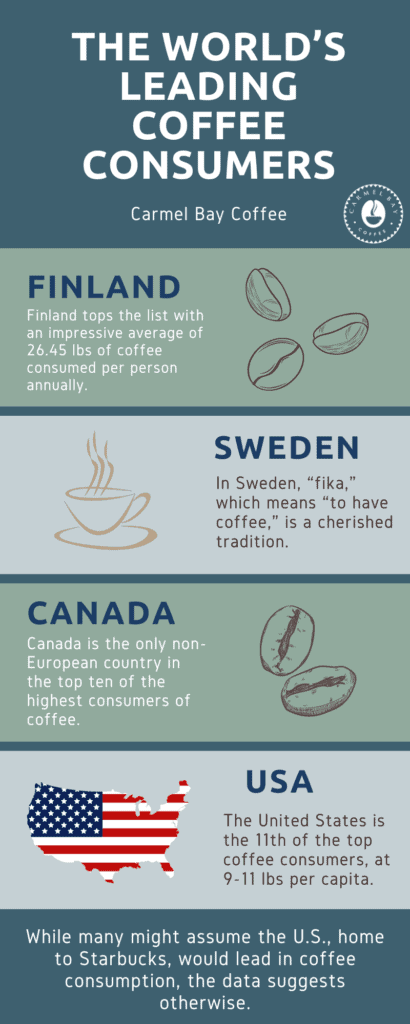
While many might assume the U.S., home to Starbucks, would lead in coffee consumption, the data suggests otherwise. Topping the charts is Finland, consuming an impressive 26.45 lbs per capita annually.
The country’s preference for light roasts and legislated coffee breaks highlight its deep-rooted coffee culture. Steeped in coffee traditions, Norway comes in second, with “karsk” – a potent mix of coffee and moonshine – being a rural favorite. Despite its chilly weather, Iceland has a thriving coffee scene, while Denmark and the Netherlands, with rich coffee histories, aren’t far behind. Sweden’s “fika” custom transforms coffee into a communal experience, and Switzerland’s fondness for “caffè crema” reflects its Italian ties.
Belgium, renowned for its chocolates, often complements them with coffee. Luxembourg, small in size, boasts a robust espresso culture. Canada, the only non-European country on the list, showcases its coffee enthusiasm through a mix of chains and independent cafes. Interestingly, the U.S., despite its pervasive coffee culture, records a consumption of just 9-11 lbs per capita, indicating that while coffee is integral to American life, its per-person consumption lags behind several European nations.
1. Finland: 26.45 lbs per capita
Finland tops the list with an impressive average of 26.45 lbs of coffee consumed per person annually. Coffee is an integral part of Finnish culture. It’s consumed throughout the day and is a staple during workers’ union-mandated coffee breaks. The Finns have a unique way of brewing coffee, similar to the Turkish method, where water and coffee grounds are repeatedly brought just to a boil. The most popular coffees in Finland are very light roasts, distinctively lighter than anywhere else globally.
Are you curious about Swedish Fika? Check out our article to discover this delightful tradition.
2. Norway: 21.82 lbs per capita
Norway’s coffee culture dates back to the early 18th century. Today, Norwegians typically drink black coffee at breakfast and with dessert after dinner. Coffee gatherings, often accompanied by cakes and pastries, are a common social activity. An interesting concoction to try in rural Norway is “karsk,” a mix of weak coffee, sugar, and a generous amount of moonshine.
3. Iceland: 19.84 lbs per capita
Iceland’s chilly climate makes a hot cup of coffee especially appealing. Reykjavik, the capital, boasts numerous independent coffee shops. The country also hosts competitions to find the best baristas and roasters, emphasizing the importance of coffee quality.
4. Denmark: 19.18 lbs per capita
Denmark’s residents consume about 1.46 cups of coffee daily. Coffee in Denmark is traditionally served at each meal and becomes the focal point during special occasions, accompanied by cookies, cakes, and small sandwiches.
5. Netherlands: 18.52 lbs per capita
The Dutch were the pioneers in European coffee cultivation, obtaining live coffee trees from Mocha, Yemen, in 1616. Today, the Dutch drink an average of 2.4 cups per day. Coffee is served during “Koffietijd” (Coffee Time), often with cookies and cakes.
6. Sweden: 18 lbs per capita
In Sweden, “fika,” which means “to have coffee,” is a cherished tradition. It implies not just having coffee but pairing it with cookies or pastries. Coffee in Sweden is more than a beverage; it’s a way of life and a social interaction.
7. Switzerland: 17.42 lbs per capita
Switzerland’s coffee culture leans towards espresso-based drinks. The “caffè crema,” similar to an Americano, is believed to have originated near Switzerland’s Italian border.
8. Belgium: 15 lbs per capita
Belgium, famous for its waffles and beer, also has a rich coffee culture. The nation has a history of pairing its renowned chocolates with coffee.
9. Luxembourg: 14.33 lbs per capita
Luxembourg, though small, has a big love for coffee. The nation boasts unique espresso drinks like “lait Russe” (Russian Milk) and “café gourmand.”
10. Canada: 14.33 lbs per capita
Canada is the only non-European country in the top ten. With popular chains and independent shops spread across the nation, coffee is the most commonly consumed beverage among Canadian adults.
11. USA: Estimated 9-11 lbs per capita
The United States, often seen as the land of opportunity, is also a nation fueled by coffee. With its vast population and diverse culture, coffee has woven itself into the very fabric of American daily life. The aroma of freshly brewed coffee is a familiar scent from the East Coast to the West, from the bustling cities to the serene countryside.
Coffee Consumption Statistics
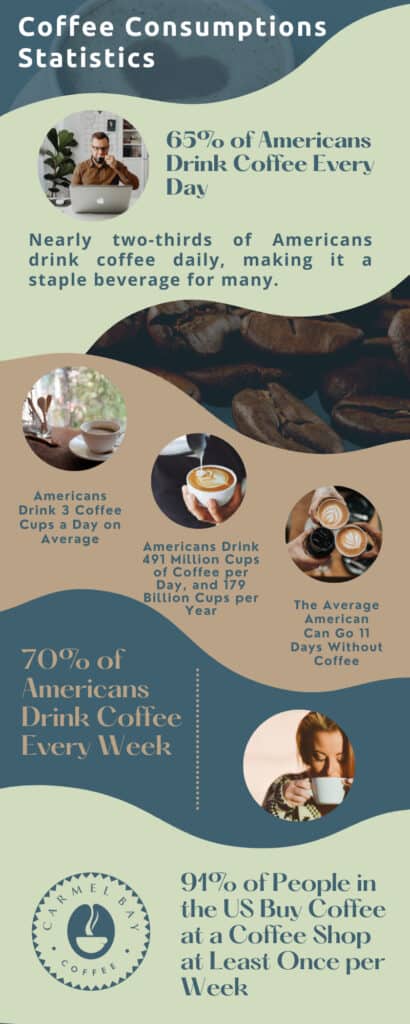
In the vast landscape of beverages, coffee reigns supreme, its steamy tendrils wrapping around the globe. But just how deep does this caffeinated love affair run?
From morning rituals to afternoon pick-me-ups, the numbers behind our collective coffee consumption tell a tale as rich and robust as the drink itself. As we venture into the heart of these statistics, we’ll uncover the patterns, preferences, and passions driving the world’s undying thirst for its favorite brew. Prepare for a deep dive into the cups, trends, and tales of coffee consumption.
65% of Americans Drink Coffee Every Day in 2023
This indicates that nearly two-thirds of the American population has made coffee a daily ritual. The consistency in consumption suggests that coffee remains a staple beverage for many.
70% of Americans Drink Coffee Every Week
Beyond daily drinkers, this statistic shows that a vast majority of Americans consume coffee at least once a week, highlighting its popularity and cultural significance.
Americans Drink 3 Coffee Cups a Day on Average
This average suggests that for many Americans, coffee is not just a morning ritual but is consumed throughout the day, possibly for its caffeine content, taste, or social aspects.
Americans Drink 491 Million Cups of Coffee per Day, and 179 Billion Cups per Year
These figures emphasize the sheer volume of coffee consumed in the US, reflecting its importance in daily life, from home brewing to coffee shop visits.
91% of People in the US Buy Coffee at a Coffee Shop at Least Once per Week
This statistic underscores the thriving coffee shop culture in the US. Whether for the ambiance, convenience, or specialty brews, Americans frequent coffee shops regularly.
The Average American Can Go 11 Days Without Coffee
While coffee is a daily habit for many, this statistic provides insight into how long Americans might go without their caffeine fix, possibly during travels, detox phases, or when trying other beverages.
Us Northeast Drank About 1.97 Cups of Coffee Per Capita per Day
Factors like climate, culture, and lifestyle can influence regional differences in consumption. The Northeast, with its cold winters, might see coffee as a warm respite.
Total Coffee Consumption Worldwide in 2021/2022 Was 178.5 Million 60kg Bags of Coffee
This global figure highlights the universal appeal of coffee, consumed in various forms from espressos in Italy to lattes in South Korea.
Europe Consumed the Most Coffee, With 55,388 60 kg Bags in 2022
Europe’s coffee culture, from the cafés of Paris to the coffee houses of Vienna, plays a role in its high consumption. The continent’s diverse coffee traditions contribute to these numbers.
Finland Consumes the Most Coffee per Person, With the Average Finn Drinking Four Cups a Day, or 26 Lbs of Coffee per Year
Finnish coffee culture is unique, with coffee breaks known as “kahvitauko” being a cherished tradition. The preference for light-roasted, filter-brewed coffee also sets them apart.
Coffee Shops Nationwide
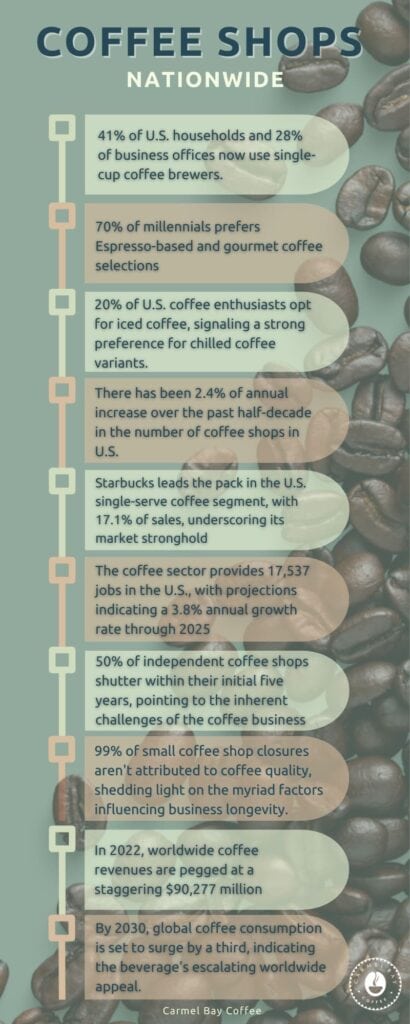
Across the U.S., coffee shops have evolved beyond mere pit stops for a caffeine jolt. They now stand as cultural epicenters, fostering community interactions and bridging the gap between traditional and contemporary brewing methods.
Whether in vibrant cities or tranquil hamlets, these venues mirror the nation’s varied palate and shifting coffee inclinations. A closer look at the country’s coffee statistics establishments unveils the distinct narratives, prevailing trends, and diverse flavors that shape the American coffee scene.
Single-Cup Coffee Brewers
Recent data shows that 41% of U.S. households and 28% of business offices now use single-cup coffee brewers. This trend underscores a move toward both convenience and individualized coffee experiences.
Millennials’ Coffee Preferences
Espresso-based and gourmet coffee selections are the choice for 70% of millennials, pointing to a generational shift in coffee tastes.
Iced Coffee Trends
Weekly, 20% of U.S. coffee enthusiasts opt for iced coffee, signaling a strong preference for chilled coffee variants.
Coffee Shop Expansion
Over the past half-decade, there’s been a consistent 2.4% annual increase in the number of coffee shops in the U.S., reflecting the nation’s deepening coffee culture.
Starbucks’ Market Position
Starbucks leads the pack in the U.S. single-serve coffee segment, accounting for 17.1% of sales, underscoring its market stronghold.
Employment in Coffee
The coffee sector provides 17,537 jobs in the U.S., with projections indicating a 3.8% annual growth rate through 2025, highlighting the industry’s role in job creation.
Challenges for Indie Coffee Shops
A sobering statistic reveals that over 50% of independent coffee shops shutter within their initial five years, pointing to the inherent challenges of the coffee business.
Behind the Closures
Contrary to assumptions, 99% of small coffee shop closures aren’t attributed to coffee quality, shedding light on the myriad factors influencing business longevity.
Global Coffee Economy
In 2022, worldwide coffee revenues are pegged at a staggering $90,277 million, emphasizing the industry’s global economic footprint.
Future Coffee Trends
By 2030, global coffee consumption is set to surge by a third, indicating the beverage’s escalating worldwide appeal.
Coffee Roast Preference Statistics

In the ever-evolving world of coffee, the debate over roast preferences is as heated as a freshly brewed cup. From the light, nuanced flavors of a blonde roast to the deep, bold notes of a dark roast, America’s palate is diverse and discerning.
But where does the nation truly stand in its roast inclinations? Dive into the latest statistics on coffee roast preferences, as we unpack the numbers behind the beans and uncover the tastes that are shaping the coffee industry’s future.
Roast Preferences Among Americans
Recent data indicates that 49% of Americans favor medium-roast coffee.
The Roast Divide
Of the American populace, 28% prefer dark roast coffee, contrasting with the 12% lean towards the light roast variant.
2020’s Roast Trend
Medium roast coffee was the choice for most U.S. coffee aficionados in 2020.
Annual Roast Coffee Trends
Over the last year, roast coffee’s popularity saw a decline of 7.49%. On an annual basis, Americans are found to indulge in roast coffee approximately 1.61 times.
Generational Shift in Coffee Habits
While it’s observed that coffee consumption tends to rise with age, there’s been a marked 40% surge in coffee intake among Americans under 40 since 2015. Notably, medium roast remains the nation’s top pick.
Blend Breakdown
In the realm of coffee blends, both dark and light roasts account for 34.78% each, with medium roast slightly behind at 30.43%.
Global Coffee Market Overview
In 2022, the international roasted coffee market stood at a robust valuation of USD 42.7 billion.
The Science Behind Roasting
Recent academic studies highlight that two critical roasting factors—namely color (or the degree of roast) and duration—play a significant role in shaping a coffee’s sensory experience.
Coffee Spending Statistics
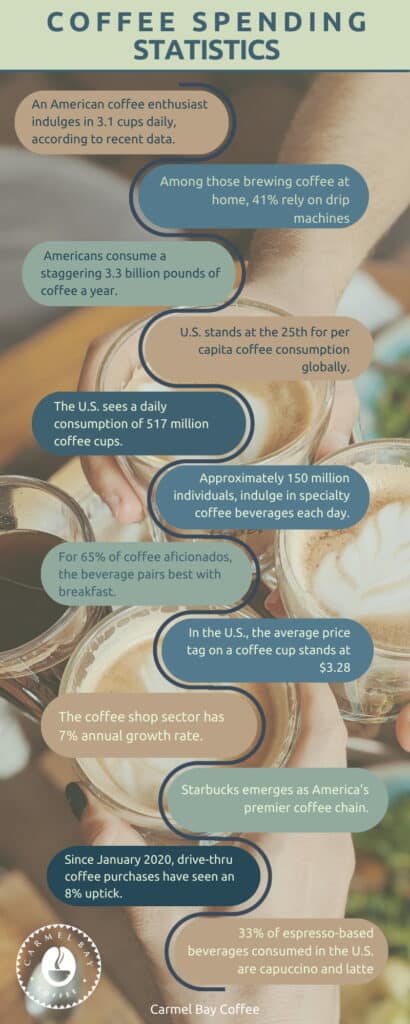
As the aroma of freshly brewed coffee wafts through the air, so does the question: How much are Americans really willing to spend on their daily jolt of caffeine? In a nation where coffee shops have become cultural landmarks and home brewing is a ritual, the economics of coffee is a story unto itself. Get ready to delve into the eye-opening figures behind America’s coffee spending. We’re breaking down the dollars and cents to reveal how this beloved beverage is not just waking us up, but also shaking up our spending habits.
Coffee Trends in America
On average, an American coffee enthusiast indulges in 3.1 cups daily, according to recent data.
Beverage Preferences
A notable 66% of Americans opt for coffee daily, surpassing even tap water consumption.
Home Brewing Methods
Among those brewing coffee at home, 41% rely on drip machines.
Annual Intake Snapshot
Fiscal reports from 2019/2020 indicate that Americans consumed a staggering 3.3 billion pounds of coffee.
Global Coffee Rankings
In terms of per capita coffee consumption, the U.S. stands at the 25th position globally.
Flavor Over Function
A significant portion of regular coffee consumers primarily savor it for its taste rather than its caffeine content.
Nationwide Daily Intake
The U.S. sees a daily consumption of 517 million coffee cups.
Specialty Coffee Trends
Half of the U.S. population, approximately 150 million individuals, indulge in specialty coffee beverages each day.
Morning Rituals
For 65% of coffee aficionados, the beverage pairs best with breakfast.
Pricing Insights
In the U.S., the average price tag on a coffee cup stands at $3.28.
Café Industry’s Trajectory
The coffee shop sector is experiencing robust growth, with an annual rate of 7%.
Leading Chains
Not surprisingly, Starbucks emerged as America’s premier coffee chain.
Drive-thru Dynamics
Since January 2020, drive-thru coffee purchases have seen an 8% uptick.
Top Espresso Picks
Cappuccinos and lattes share the spotlight, each accounting for 33% of espresso-based beverages consumed in the U.S.
Health Benefits of Coffee Statistics
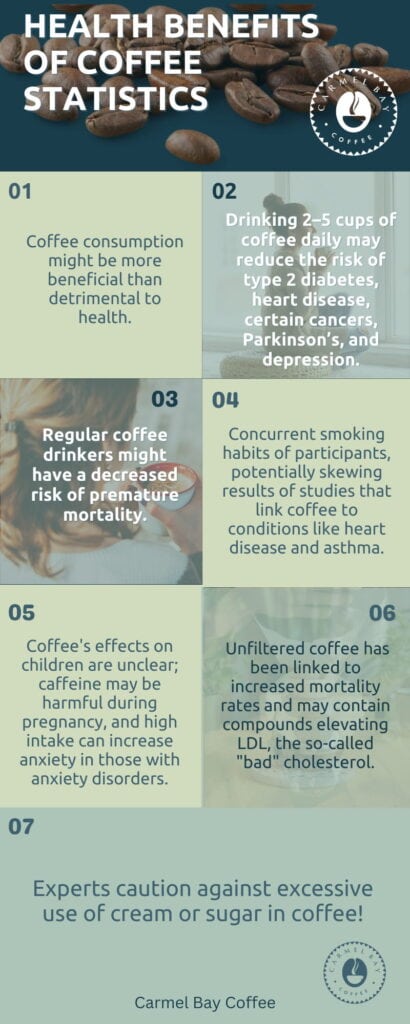
For many, the morning cup of coffee is a non-negotiable ritual, a lifeline to kickstart the day.
But beyond its invigorating aroma and taste, what does science say about the health implications of this beloved brew? As researchers dive deeper into the cup, the findings stir more than just spoons.
Let’s get into the latest Health Benefits of coffee statistics. Shedding light on the health benefits of coffee and how this age-old beverage might be contributing to more than just our morning alertness.
Coffee’s Health Implications
Recent studies suggest that coffee consumption might be more beneficial than detrimental to health.
Balanced Coffee Intake
Consuming a moderate 2–5 cups of coffee daily has been associated with a reduced risk of ailments such as type 2 diabetes, heart disease, certain cancers, Parkinson’s disease, and depression.
Longevity and Coffee
Regular coffee drinkers might have a decreased risk of premature mortality.
Historical Research Pitfalls
Initial studies erroneously linked coffee to conditions like heart disease and asthma. A significant oversight in these studies was the concurrent smoking habits of participants, potentially skewing results and misattributing the harmful effects of tobacco to coffee.
Potential Concerns
The impact of coffee on children remains largely uncharted, and caffeine might pose risks during pregnancy. Moreover, individuals with anxiety disorders could experience heightened anxiety with excessive caffeine intake.
Optimal Brewing Techniques
Coffee aficionados are advised to use paper filters when brewing; unfiltered coffee has been linked to increased mortality rates and may contain compounds elevating LDL, the so-called “bad” cholesterol.
Mindful Additions
Experts caution against excessive use of cream or sugar in coffee.
At-Home Coffee And Coffee Brewing Methods

In the intimate corners of American kitchens, a revolution brews. As the allure of barista-made coffee remains undeniable, an increasing number of aficionados are seeking that perfect cup within the confines of their homes.
But how are they achieving it? From French presses to pour-overs, from espressos to cold brews, the methods are as varied as they are intricate. These are coffee statistics about the ways we brew.
Pour Over/Drip Methods
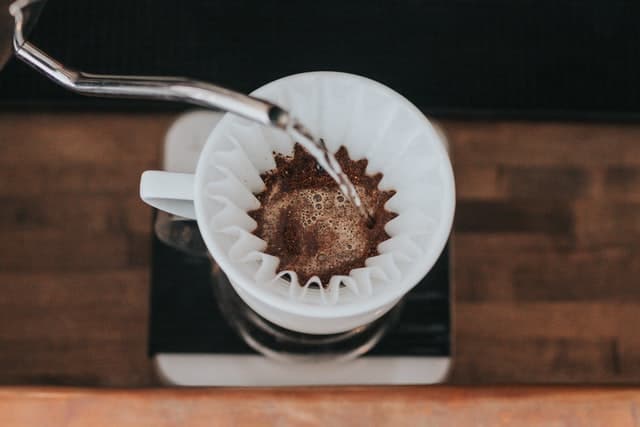
The Coffee Cone, a straightforward and cost-effective method, involves pouring hot water over coffee grounds held by a paper filter. The brewed coffee then drips directly into a container. Notable brands championing this method include Melitta, Hario V60, Kalita Wave, and Bee House.
Chemex

A fusion of design and function, the Chemex, crafted in 1941 by Dr. Peter Schlumbohm, is a glass vessel that employs a unique, thicker paper filter. The flask’s base serves as a carafe for the brewed coffee.
Plunger/Press Techniques
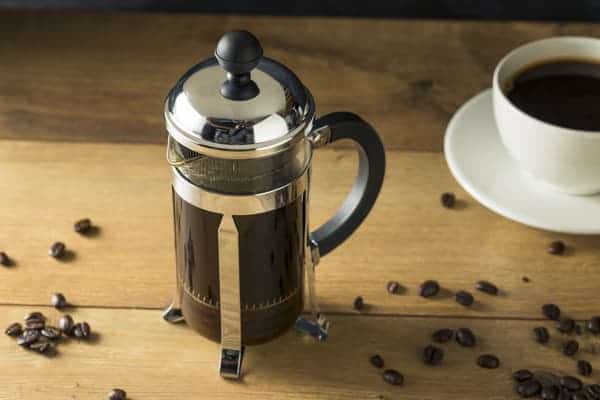
The French Press, introduced in 1929, is lauded by many coffee enthusiasts for its ability to extract rich flavors. This method involves soaking, steeping, and straining coffee in hot water.
AeroPress
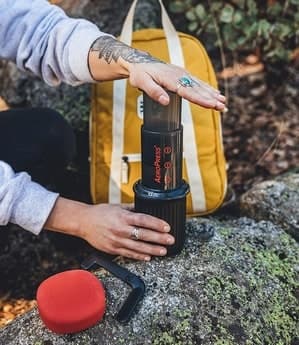
A 2005 invention by Aerobie Frisbee’s Alan Adler, the AeroPress is a plastic apparatus that uses a plunger mechanism, leveraging air pressure to push brewed coffee through a filter.
Percolate
The Stovetop Moka Pot, a design patented in 1933 by Alfonso Bialetti, brews coffee by using steam pressure from boiling water to pass through coffee grounds, collecting the brew in an upper chamber.
Vacuum Brewing
The Siphon, a German invention from the 1840s, employs a dual-chamber system. Coffee grounds are placed in the top vessel, and vapor pressure pushes hot water upwards to immerse the grounds. Once the heat source is removed, gravity pulls the brewed coffee through a filter into the lower chamber.
Brewing Insights
For optimal home brewing, experts suggest rinsing filters to eliminate potential chemical residues, using a narrow-spouted kettle for uniform water distribution, starting with cold filtered water, grinding fresh roasted beans immediately before brewing, and pre-heating equipment and cups to maintain coffee temperature.
For more information on making the best coffee with a Moka Pot, please take a look at our article here.
Coffee Subscription Facts
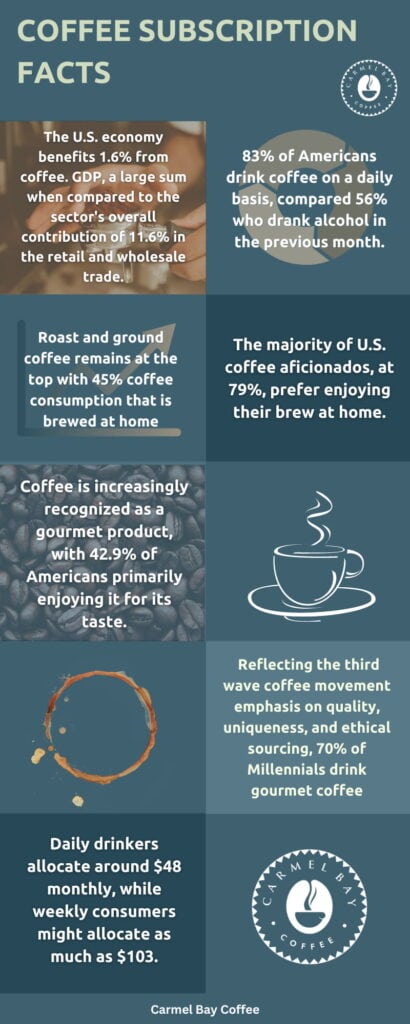
In an era where convenience is king, and our doorsteps have become the new marketplace, the coffee industry is brewing a fresh trend: subscriptions.
No longer confined to magazines or streaming services, the subscription model has found its way into the aromatic world of coffee beans and blends. But how widespread is this phenomenon, and what’s driving java enthusiasts to get their caffeine fix delivered regularly?
Coffee’s Economic Footprint
Coffee commands a notable 1.6% of the U.S. GDP, a significant figure when compared to the entire retail and wholesale trade sector’s 11.6% contribution.
America’s Coffee Culture
A robust 83% of Americans indulge in coffee, with nearly two-thirds sipping a cup daily. This contrasts with the 56% who reported consuming alcohol in the past month.
Home Brew Dominance
The majority of U.S. coffee aficionados, at 79%, prefer enjoying their brew at home.
Roast and Ground Coffee’s Popularity
For those brewing at home, roast and ground coffee remains the top choice, making up 45% of their coffee consumption.
Coffee’s Artisanal Evolution
Coffee is increasingly celebrated as a gourmet product, paralleling the likes of wine or cheese. Notably, 42.9% of Americans primarily relish coffee for its taste.
Millennials’ Gourmet Inclination
A significant 70% of coffee consumed by Millennials falls under the gourmet category, echoing the third wave coffee movement’s emphasis on quality, distinctiveness, and ethical sourcing.
Single-Origin’s Premium Appeal
Consumers exhibit a marked preference for single-origin coffees, demonstrating a willingness to pay nearly double for those with a distinct country of origin. This preference surpasses other attributes such as Fair Trade, organic certifications, or familiar brand names.
Local Roasters’ Value
Coffee enthusiasts tend to splurge on offerings from local roasters, often shelling out up to $25 per pound, compared to roughly $20 for premium non-local alternatives.
Subscription Spending Dynamics
Interestingly, the frequency of coffee consumption inversely correlates with monthly expenditure. Daily drinkers allocate around $48 monthly, while weekly consumers might allocate as much as $103.
Emerging Subscription Models
Modern coffee subscription services are pivoting towards local roasters, exclusively offering single-origin beans, providing smaller quantities, accentuating flavor profiles, and streamlining the subscription experience.
Coffee Statistics About Espresso
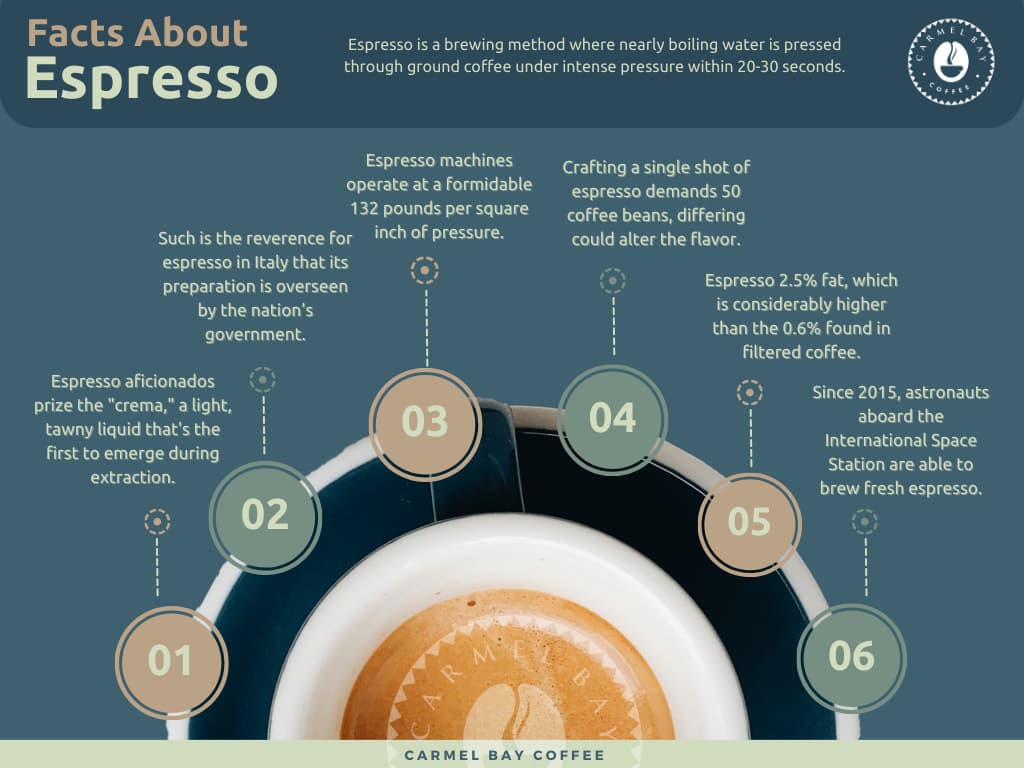
In the bustling world of coffee, the espresso stands as both a classic and a conundrum. A concentrated shot that has fueled nations and sparked countless debates over its perfect preparation. But what lies beneath the crema? What tales does this dark, aromatic elixir hold?
Check out these coffee statistics about espresso. Uncover the facts and figures that define its storied history, its global impact, and its undeniable place in the heart of coffee culture.
Espresso Explained
Contrary to common misconceptions, espresso isn’t a specific coffee bean or roast. It’s a brewing method where nearly boiling water is pressed through finely ground coffee under intense pressure, typically within 20-30 seconds.
The Art of Crema
Espresso aficionados prize the “crema,” a light, tawny liquid that’s the first to emerge during extraction.
Italy’s Espresso Standards
Such is the reverence for espresso in Italy that the nation’s government oversees its preparation.
Machine Mechanics
Espresso machines operate at a formidable 132 pounds per square inch of pressure, a stark contrast to the gravity-driven process of traditional drip coffee makers.
Precision in Every Shot
Crafting a single shot of espresso demands 50 coffee beans, and the inclusion of even one inferior bean can alter the flavor profile.
Fat Factor
Espresso, being an emulsion, contains 2.5% fat, which is considerably higher than the 0.6% found in filtered coffee.
Cosmic Coffee
Since 2015, astronauts aboard the International Space Station have had the privilege of brewing fresh espresso, elevating their coffee experience to interstellar heights.

